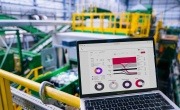Single-stream commingling economically and environmentally detrimental, European Commission says
New study concludes single-stream commingling is noncompliant with the EU Waste Framework Directive (WFD) and recommends EU nations implement separate collection systems for dry recyclables, accompanied by centralised sorting plants.
The study, conducted by the European Commission’s Joint Research Centre (JRC), assessed various systems used across the EU to separate, collect and manage dry recyclables - covering beverage cartons, glass, metal, plastic, paper and cardboard put in municipal waste.
 The summary report recommends best practices, including how member states can be compliant with the EU's soon-to-be-updated WFD, which mandates separation of dry recyclables.
The summary report recommends best practices, including how member states can be compliant with the EU's soon-to-be-updated WFD, which mandates separation of dry recyclables.
Data collected by the JRC reveals that in the vast majority of cases, EU nations are not enforcing separate collection of dry recyclables and are instead using some form of commingling. This is largely due to techno-economic constraints but is also a result of poor collection practices.
Mitigating climate change and increasing recycling rates are key objectives of the EU Green Deal and Circular Economy Action Plan. Improving plastic recycling is particularly important in emissions reduction as a significant proportion of uncollected plastic waste is currently incinerated.
Single-stream vs multi-stream collection
The JRC study finds that higher degrees of waste separation generally deliver better environmental outcomes. However, it also reports that there is no substantial difference in economic and environmental outcomes when comparing three- and four-stream collection systems.
Some dual-stream systems perform as well as three- and four-stream systems, but only if paper and cardboard are kept separate from other dry recyclables (or commingled with beverage cartons only).
Single-stream collection incurs the worst environmental and economic effects, while dual-stream systems where paper and cardboard are commingled with other materials also perform poorly. This holds true even when single- and dual-systems are accompanied by deposit refund schemes for specific materials (e.g. PET bottles).
According to the report, poor economic performance in single-stream systems is due to lower levels of secondary material recovery. Three- and four-stream systems incur higher collection, sorting and transport costs but lower net costs at the system-wide level due to the revenues from secondary materials.
Recommendations from the report
The report recommends that EU nations implement well-designed separate collection systems for dry recyclables, having assessed the related economic, environmental and social impacts. Centralised sorting plants should complement separated collection systems, not replace them.
Single-stream commingling practices should be considered as noncompliant with WFD and not allowed as possible derogations.
That said, the JRC concludes that some degree of commingling can be safely accepted and that reducing the overall number of waste streams collected may deliver benefits in terms of space and convenience (although these benefits were not assessed quantitatively in this study).
The report highlights the variation in collection schemes across and within EU member nations and notes the importance of flexibility when designing waste management strategies: “One solution does not fit all, i.e. collection depends on several factors (e.g. geography, demography, climate) and what is successful in one specific context might not be in another.”
Study methodology
The study evaluated 65 of the most relevant recyclables management practices, which reflect the main variations of commingling systems across the EU. The environmental and economic impacts of each practice were analysed using life cycle assessment and life cycle costing, covering all stages of the recycling process from initial collection to final recovery or disposal.
Life cycle assessments considered 16 environmental impacts, including climate change, ozone depletion, radiation and water use. Life cycle costs considered internal costs (monetary transactions - e.g. fees and taxes) and external costs or ‘externalities’ (non-monetary items - e.g. impact on air quality).
More information on the study’s methodology, background and findings can be found on the official website of the EU.








